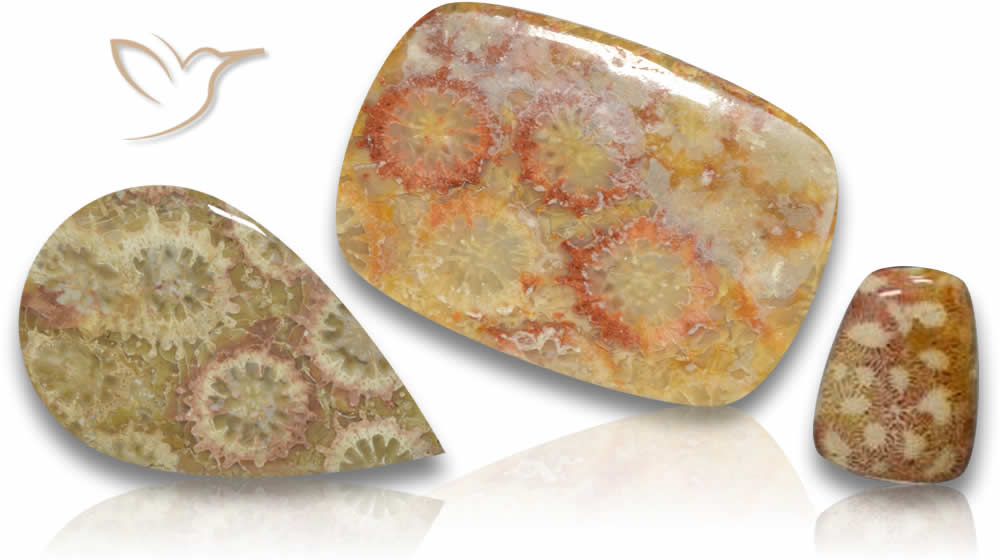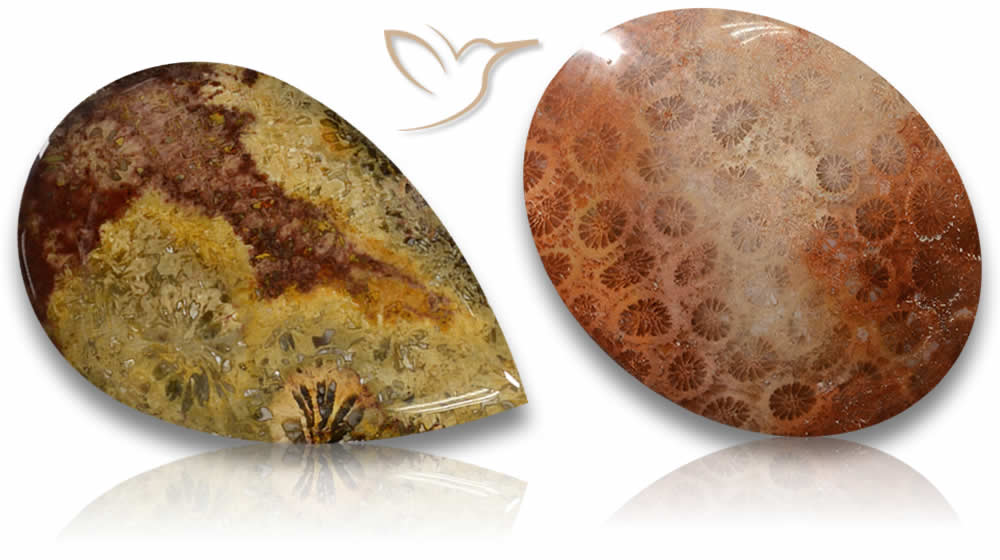Fossil Coral Gemstone: Beauty & Timelessness

Fossil coral gemstone is a captivating natural gem formed from the ancient remains of coral that has been transformed over millions of years into a beautiful, durable stone. With its intricate patterns and rich history, fossil coral offers a unique blend of nature’s artistry and geological wonder. Often found in shades of cream, beige, and brown, it features striking patterns that mimic the delicate structures of marine life.
Fossil coral stone is not only sought after for its distinctive appearance but also for its connection to the Earth’s ancient past. In this article, we will explore the origins, characteristics, and significance of fossil coral, shedding light on its appeal to collectors and those who value its timeless beauty. Discover our collection of fossil coral for sale.
Key Takeaways:
- Learn about the allure and ancient beauty of fossil coral gemstones
- Discover the unique qualities that set fossil coral gemstones apart from other gemstones
- Explore the many uses of fossil coral gemstones, from jewelry to healing practices
- Unlock the secrets of fossil coral gemstone jewelry, including its stunning designs and styles
- Uncover the believed healing properties of fossil coral gemstones, including their link to emotional healing, stress reduction, and balance
What is Fossil Coral Gemstone?
Fossil coral gemstone is a unique type of gemstone that originates from ancient coral reefs. Over time, minerals replace the coral structure, resulting in a stunning stone that showcases the intricate details of the original coral. The formation process takes thousands of years, making fossil coral gemstones truly rare and one-of-a-kind.
To identify fossil coral gemstone, there are a few key characteristics to look for. Firstly, the gemstone should feature small, distinct patterns that resemble coral. The patterns should be visible to the naked eye and create a unique sense of depth and texture in the stone. Secondly, fossil coral gemstones are typically found in shades of red, brown, and orange, although some may also feature blue or green hues. Finally, the gemstone has fairly good hardness with a hardness of around 6.5 to 7 on the Mohs scale.
Fossil Coral Gemstone Characteristics:
| Characteristics | Description |
|---|---|
| Patterns | Small, distinct coral-like patterns |
| Color | Shades of red, brown, and orange. Some may also feature blue or green hues. |
| Hardness | 6.5 to 7 on the Mohs scale |
Fossil coral gemstone is a fascinating and unique gemstone that has become increasingly popular in recent years. Its distinct appearance and natural beauty make it a sought-after material for both jewelry and metaphysical practices.
Properties of Fossil Coral Gemstone
The fossil coral gemstone is a unique and sought-after gemstone, prized for its distinct physical properties. Here are some of the most notable properties of fossil coral gemstone:
| Property | Description |
|---|---|
| Hardness | The fossil coral gemstone has a Mohs hardness ranging from 6.5 to 7, rendering it suitable for all kinds of jewelry designs including daily-wear rings. Even though fossil coral has fairly good hardness and durability, there are still a variety of other materials which can easily scratch it. Therefore, avoid wearing, mixing or storing it with other gems, whether softer or harder, in order to prevent scratches and fractures. |
| Color variations | Fossil coral gemstones can come in a range of colors, depending on the minerals present during the fossilization process. Common colors include shades of white, pink, brown, and red. |
| Unique patterns | Each fossil coral gemstone has a distinct pattern, created by the ancient coral structures that were preserved during the fossilization process. These patterns can be mesmerizing and make each stone unique. |
The properties of fossil coral gemstone make it an excellent choice for jewelry pieces and metaphysical practices. Its natural hardness and unique patterns make it an attractive option for jewelry makers, while its perceived healing properties and ancient energy make it desirable in the metaphysical community.
Uses of Fossil Coral Gemstone
The fossil coral gemstone has been utilized for various purposes over the years, thanks to its unique properties and natural elegance. Here are some of the ways in which this gemstone is used:
Jewelry
The fossil coral gemstone is popularly used in crafting distinctive jewelry pieces due to its intricate patterns and colors. It is often incorporated into necklaces, earrings, bracelets, and rings, adding a touch of natural beauty to any jewelry collection. The gemstone's timeless appeal and rarity also make it a unique choice for special occasions or meaningful gifts.
Healing Properties
In addition to its visual appeal, the fossil coral gemstone is also believed to possess healing properties. Some people use it in their metaphysical practices to promote wellness, emotional balance, and calmness. It is said to help reduce stress and anxiety, boost self-esteem, and encourage feelings of compassion.
Spiritual Significance
Some cultures and religions have assigned specific spiritual significance to the fossil coral gemstone. For instance, in ancient times, it was believed to be a symbol of life and resurrection. Today, some belief systems recognize it as a powerful tool for promoting spiritual growth and enlightenment.
Due to its versatility and unique qualities, the fossil coral gemstone continues to be a popular choice for various applications.
Fossil Coral Gemstone Jewelry
When it comes to accessorizing with natural gemstones, fossil coral gemstone jewelry is a popular choice that effortlessly adds an exquisite touch to any outfit. The unique patterns and hues of fossil coral make it an interesting gemstone to work with when designing jewelry pieces.
The jewelry industry has capitalized on the beauty of fossil coral, offering an array of designs and styles that cater to different fashion themes and personal preferences. From delicate earrings to statement necklaces, bangles, and rings, there's no shortage of choices when it comes to fossil coral gemstone jewelry.
One of the benefits of fossil coral gemstone jewelry is it's versatility. Whether you want to add a pop of color to your boho look or add an earthy touch to a power outfit, fossil coral jewelry can do both. Its timeless and natural beauty also lends itself to being paired with other gemstones or precious metals.
Popular Fossil Coral Jewelry Designs
| Jewelry Type | Description |
|---|---|
| Rings | Fossil coral gemstones are set in different ring band materials and styles. They can either be the centerpiece of the ring or used as accent stones. |
| Necklaces | From chokers to longer chain necklaces, fossil coral gemstones are set in different pendant designs and settings. |
| Bracelets | Fossil coral gemstone bracelets come in dainty and bold styles, using various setting styles. |
| Earrings | Fossil coral gemstones adorn different earring styles, such as studs, hoops, and drop earrings. |
Whichever fossil coral gemstone jewelry you choose, make sure to pair it with a complementary outfit and let it be the standout piece.
Moreover, it's essential to keep fossil coral gemstone jewelry clean and adequately stored when not in use to extend their lifespan. Avoid exposing it to abrasive chemicals and harsh environments for longevity.
Fossil Coral Gemstone Healing Properties
Fossil coral gemstone has been used for centuries for its believed healing properties, and we will explore some of these in this section. It is thought that this gemstone may help with emotional healing, promoting feelings of calmness and balance.
Some practitioners feel that fossil coral gemstone can help reduce stress and anxiety, as well as negative thought patterns. It is also believed to encourage inner peace and serenity, assisting with focus and clarity of mind.
Additionally, some people use fossil coral gemstone for physical healing purposes, such as to strengthen bones and help with digestive issues. It is important to note that these beliefs have not been scientifically proven, and it is advised to seek medical attention from a trained healthcare professional for any serious health concerns.
For those who wish to harness the healing properties of fossil coral gemstone, there are several ways to incorporate it into daily life. One way is to wear it as jewelry, allowing the gemstone to be in close contact with the body. Another option is to carry a small piece of the gemstone with you throughout the day, or to place it in a prominent location in your home or workspace.

Whether or not you believe in the healing properties of fossil coral gemstone, its natural beauty and unique patterns make it a stunning addition to any collection.
Conclusion
Now that you know all about the beauty and properties of fossil coral gemstone, you may be ready to purchase some for yourself. When buying fossil coral gemstone, it is important to ensure it is authentic. Gemselect only sell authentic fossil coral and we offer a certification service from independent gemological laboratories.
Once you have your authentic fossil coral gemstone, it is important to take care of it properly. Clean it regularly using a gentle soap and water, and avoid exposing it to harsh chemicals or extreme temperatures.
Whether you plan to use your fossil coral gemstone for jewelry making or healing purposes, it is an incredibly unique and special gemstone with a rich history and deep meaning. We hope you enjoy exploring all the possibilities that come with this timeless gemstone.
FAQ
What is a fossil coral gemstone?
Fossil coral gemstone is a type of gemstone that is formed from the fossilized remains of coral polyps. It is a unique combination of organic material and minerals, resulting in a beautiful and distinctive gemstone.
How can I identify a fossil coral gemstone?
Fossil coral gemstones can be identified by their intricate patterns and textures, reminiscent of coral reefs. These patterns often resemble flowers, tree branches, or honeycombs. Additionally, their hardness level and resemblance to the original coral structure can help in identification.
What are the properties of fossil coral gemstone?
Fossil coral gemstones have a hardness level of 6.5 to 7 on the Mohs scale, making them relatively durable for jewelry purposes. They come in a variety of colors, including shades of white, pink, red, brown, and black. Each gemstone is unique, showcasing beautiful patterns and formations.
How can fossil coral gemstones be used?
Fossil coral gemstones are commonly used in jewelry making, including rings, bracelets, necklaces, and earrings. They can also be used as decorative pieces or incorporated into artwork. Some people believe that fossil coral gemstones possess healing properties and use them for meditation and energy work.
What are some examples of fossil coral gemstone jewelry?
Fossil coral gemstone jewelry can range from delicate and intricate silver or gold settings to statement pieces with large, bold gemstones. Some popular choices include fossil coral rings, pendants, and earrings, often paired with other complementary gemstones or materials.
What are the healing properties of fossil coral gemstone?
Fossil coral gemstones are believed to promote emotional healing, reduce stress, and provide a sense of calmness and balance. They are also associated with grounding and connecting to the earth's energy. However, it's important to note that these beliefs are based on metaphysical perspectives and should not replace medical advice or treatment.
Where is fossil coral found?
Almost all fossil coral specimens are found in Indonesia or the United States, Florida and Georgia in particular. Florida has even declared Fossil Coral as the official 'Florida State Rock'. Indonesian fossilized coral is considered to be the most desirable and unique.
How should I care for my fossil coral gemstone?
Fossil coral gemstones should be treated with care to maintain their beauty and integrity. Avoid exposure to harsh chemicals, including bleach and acidic substances. Clean them with a soft cloth and mild soap, and store them separately from other gemstones to prevent scratches. Periodic re-polishing or restringing may be necessary depending on the type of jewelry piece.

